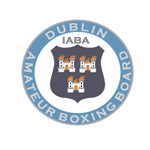Arbour Hill Boxing Club

Standing left to right: E. Kennedy (Hon. Sec); C. Hensey; M. Hensey; F. Caulwell (Official)
Seated left to right: W. Lenehan; E. Kennedy; J. Saunders (Juvenile Captain); J. Malone, H. Byrne
Arbour Hill Boxing club was renowned in the early days of Irish boxing for having a particular ‘style’; hands well up, straight stance, body turned so that the opponent only got a side view and the chin sunk well down behind the left shoulder. Many did not like it at the time, while others had a sneaking regard for it. Anyway, that was the thing they were most proud of in Arbour Hill Boxing Club. They gave the Arbour Hill ‘style’ to Irish boxing, for better or for worse. Given the record of that club, it was clearly for ‘better’. The club was founded in 1931 by Rev John McLoughlin (a man whose name featured in almost ever aspect of the administration and development of Irish boxing). They were fortunate to have a popular and energetic secretary in the person of Sgt Ned Kennedy. Training was in the hands of Sgt Jimmy Cullen who made no secret of his claim to be the Number One producer of champions. Arbour Hill have a distinguished roll of honour – names that have made amateur boxing history. The incomparable Mick Coffey – Irish Champion in 1935, 38 and 42, and of whom The Boston Daily Record wrote that “at least a dozen professional promoters, including Jack Sharkey, saw themselves facing happy days of ease in Mick’s earnings in the ring”, if he had consented to enter the professional ranks.
The fearless Frankie Kerr had captured his fifth National Senior title a month after he had celebrated his 21st birthday. The dedicated Mick Dowling, Irish bantamweight champion 1968 – 1975, Irish Olympic representative in Mexico 1968 and Munich 1972, was European bronze medallist in 1969 and again in 1971. In 1938, Arbour Hill set a record that is unlikely ever to be repeated, winning 4 National Senior titles from the 8 weight divisions being boxed at that time. Frankie Kerr at bantamweight, Jackie Saunders at Feather, Sean Clancy at Feather while Mick Coffey took the middleweight title. It would take a full publication to cover the exploits of champions like Brendan McCarthy, Willie Byrne, Jim Byrne, Liam Clarke, Eddie Hayden, Benny Carabini, Willie Lenihan and Steve Coffey, brother of Mick who, in later years, went on to give dedicated service to the Dublin County Board. Perhaps, on another occasion, somebody will take the time to produce a full, detailed history of this remarkable club.
St Andrews Boxing Club
The year 1924 marked an important milestone in the history of Irish Societies generally. In that year, Ireland competed as such in the Olympic Games in Paris. Those interested in the administration of sport did trojan work in building up several national Associations which had become more or less moribund through the effects of the First World War and the disturbed years at home from 1920 to 1923. The IABA, with limited resources, did wonderful work in 1924 and it can be said that a big part was played by the St Andrews Club. That club was founded in 1922 by William Carroll (Sen), William Carroll (Jun) and Bill McDonald, and from its inception, was one of the strongest units in the IABA. William Carroll (Sen), Irish Featherweight Champion in 1911 and Bill McDonald, Irish heavyweight Champion in 1911, had been key figures in founding the IABA in 1911. Incidentally, William Carroll (Jun) was Irish Flyweight Champion in 1923. St Andrews Boxing Club had its ups and downs but, even during the ‘down’, managed to maintain its well-earned name as a first class club. Its first premises was in Sandwith Lane (colloquially known as Candy Sauce Lane) and from there the club moved to Lombard St in 1927. In 1929 the headquarters were moved to 42 York St where the club remained for many years. From the beginning, the club developed juvenile boxing and was indeed the pioneer of this very important feature of the work of the IABA. For many years, the men of St Andrews were ‘voices in the wilderness’ but finally, their consistent demands for the recognition of the juvenile found favour with the IABA and a start was made in 1926. The St Andrews club deserves recognition for being the pioneers of this hugely important aspect of the IABA’s activities.The boxing ‘roll of honour’ of the club is indeed a distinguished one. The members who won Irish Senior titles were: Flyweight William Carroll, W M Rodgers, Sean Tallon, Jimmy Ingle, Jack Foley (2) Bantamweight George Collins Featherweight Paddy Byrne (3), Ernie Smith, Paddy Gernon Lightweight Mick Muldoon, Ernie Smith (6), Jack Kennedy, Paddy Gernon, Jimmy Ingle, Andy McDermott Welter Jack Kennedy (2), Tommy Byrne, Paddy Gernon (2) To Jimmy Ingle fell the honour of winning for Ireland her first European Championship at the National Stadium in 1939. On the administration side also, St Andrews rendered distinguished service to amateur boxing. The roll of honour included: President IABABill McDonald; 1933 – 1937 Vice President IABA William Carroll (Sen); 1933 – 1934P J Kilcullen; 1933 – 1936 Secretary IABA P J Kilcullen; 1941 – 1944 Treasurer IABA P J Kilcullen; 1930 – 1931 President of Dublin County Board P J Kilcullen; 1934 – 1941 Words are incapable of expressing the extraordinary input of those gentlemen in the development of amateur boxing, not only in Dublin but throughout the entire country.

